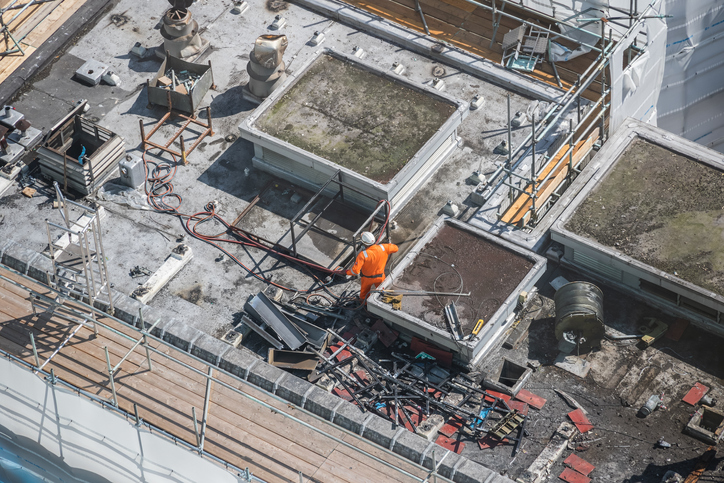
Extending buildings upwards by utilising existing and unused rooftops is an innovative way to create space. The Government is keen to encourage upwards development as a solution to the housing crisis and as a result has introduced permitted development rights to facilitate such work. Whilst the permitted development rights certainly make the planning process much easier, there are other factors that need to be considered before extending into the airspace of a building.
Who owns the airspace?
Where the whole or part of the Property has been let, the provisions of any leases will need to be checked carefully to ensure that the airspace has not been let to a tenant and/or rights have not been granted over the airspace that would prevent development. If such rights are in place, then the lease(s) would need to be varied by Deed to permit such development and the tenants may either refuse consent or require a premium for agreeing to the variation.
Tenant’s right of first refusal
The Landlord and Tenant Act 1987 gives certain tenants a right of first refusal where a landlord seeks to make a disposal. This will catch a sale of the freehold but also a lease of the airspace. Therefore, where a landlord proposes granting a lease of airspace to a builder to carry out the development or has developed the airspace itself and subsequently wishes to grant a long lease, it will need to comply with the provisions of the Act by giving the tenants the right to take the lease themselves.
Failure to comply with the Act is a criminal offence punishable by an unlimited fine. The tenants also have rights against the purchaser and may be able to force the purchaser to sell the airspace property to them on the same terms.
Rights to Light
A right to light, is the right of a building owner or occupier to receive direct light through windows or other openings in that building. These rights attach to buildings and not land, so undeveloped land cannot acquire a right to light over an adjoining property.
Extending into the airspace in an urban area is very likely to affect rights of light enjoyed by neighbouring properties. A developer should obtain a rights to light survey to assess the potential impact of the development on the surrounding properties.
Indemnity insurance can be obtained to protect against this risk; however, the insurers are likely to require a copy of the rights to light survey and planning permission to be able to fully consider the risks. A developer may therefore need to expend significant amounts before obtaining a decision on whether insurance is available.
If a survey determines that adjoining properties benefit from rights to light, it is possible to extinguish such rights by:
- Written agreement
- Unity of ownership – i.e., the developer acquires the benefitting property (but only where these is no leasehold interest)
- Abandonment – where the benefitting building has “abandoned” the right, say by blocking up the windows. A developer should be cautious in relying on this option as case law has held that blocking up windows for 20 years did not lead to abandonment.
- Demolition/ alteration of the benefitting property, where the windows do not remain in their original places
- Compulsory purchase rights have been exercised that override such rights.
Party Walls
The Party Wall etc. Act 1996 applies to horizontal as well as vertical structures such as floors or ceilings. A developer should consult a party wall surveyor before considering development of the airspace to ensure that the required notices are served.
Rights of Existing Tenants
Development in the building is very likely to cause disruption to any existing occupiers – such as dust, noise, scaffolding and vibrations. Occupiers are therefore likely to take any possible action to prevent development.
Where the whole or parts of the building have been let, the terms of those leases may conflict with development. There may be rights of access to the airspace, or there may be obligations on the landlord not to let the airspace. Where the lease contains a – very common – provision requiring the landlord to only grant leases on similar terms within the building, it could be in breach of the lease by allowing a tenant of the airspace to carry out structural alterations, which are usually prohibited in multi tenanted buildings.
The Landlord will also need to ensure that it has reserved sufficient rights in the lease to allow it to develop the building – such as rights to erect scaffolding and to upgrade/ connect into the services.
Service Charges
Where the number of flats in a building is being increased, a landlord may wish to vary the service charge proportions between the tenants. The terms of the leases should be examined to see if this is permitted or alternatively the statutory procedure may be used to allow for this.
Funding
Airspace finance requires niche funding so careful consideration should be given if the developer/ owner requires finance for the works. A lender is likely to require step in rights for any build contract and warranties from the professionals involved in the construction.
Whilst the planning system has been simplified to enable airspace development, such rights are subject to detailed conditions and limitations. Even where the development is permitted, upwards development also comes with many other potential issues. If you would like to discuss any aspect of airspace development, then please contact Kate Burlinson by email at Kate.Burlinson@bhwsolicitors.com or by phone on 0116 402 9022.
Categorised in: Commercial Property, New Build, Residential Property
Tags: Commercial Property, Residential Development, Residential Property